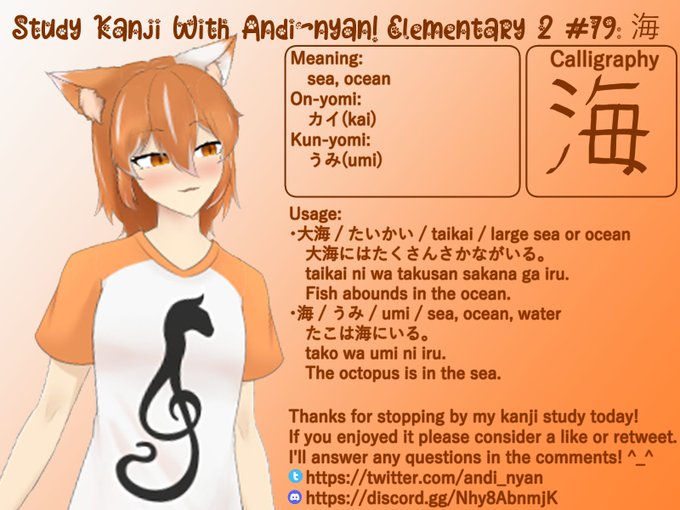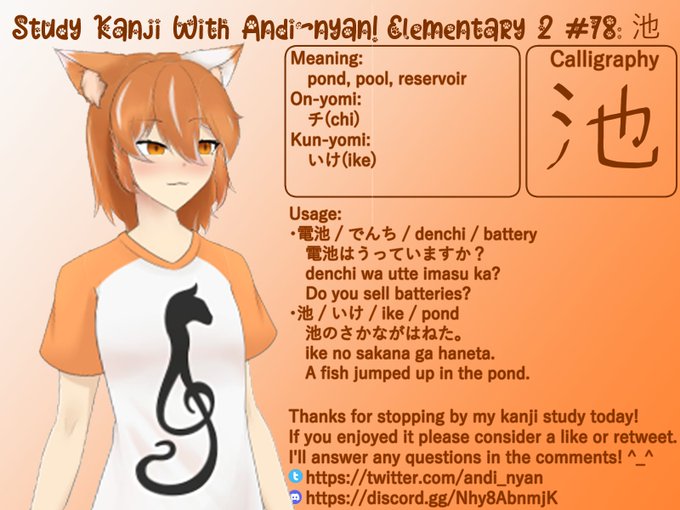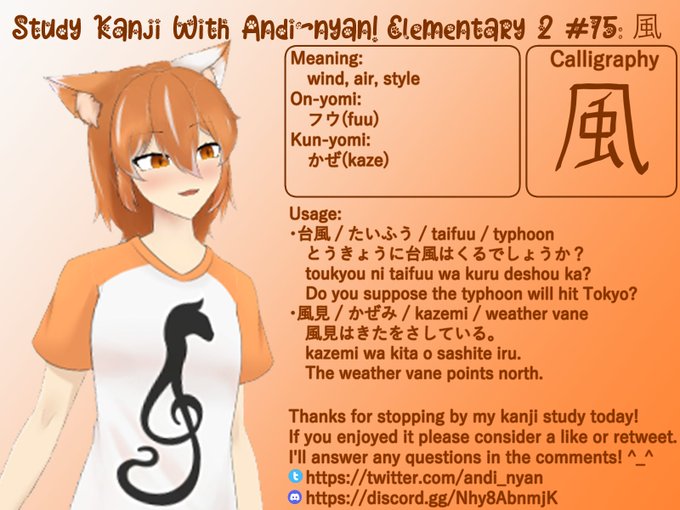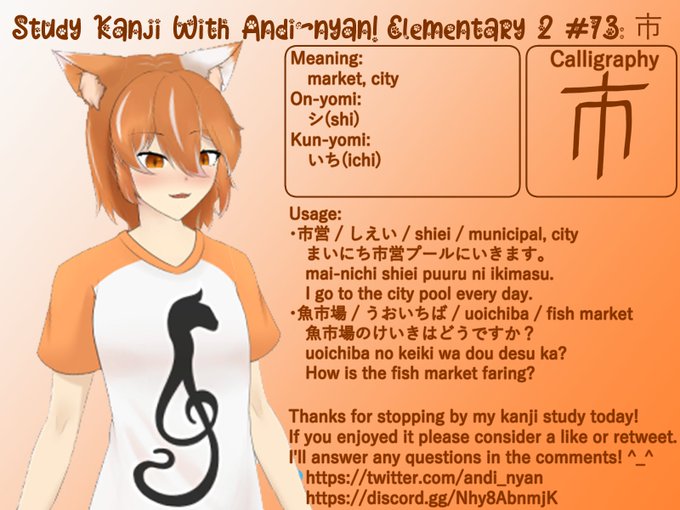kanjisのTwitterイラスト検索結果。 214 件中 3ページ目
Good afternyan! Today's #kanjistudy features 声, voice!
A word of warning, the top component isn't 土(tsuchi, earth), but 士(samurai).
So that's how you can remember this - samurai have to have very loud voices!
にゃりがとう! またあした! See you tomorrow!
#ENVtuber #VtuberTwP
Good afternyan, and welcome to my #kanjistudy, today featuring 答, solution/answer!
It was hard to come up with a mnemonic to remember this with; the best I could do was going into the bamboo 竹 to meet 合 the answer.
I'd love to hear any ideas you have!
#ENVtuber #VtuberTwP
ようこそ! My kanjistudy today is on 言, say or word!
I tend to think of this kanji as being like the sound coming out of someone's mouth 口 as an aid to remembering it.
Thanks for stopping by! I always appreciate it. ^_^
またあした!
#ENVtuber #VtuberTwP
Good afternyan! Here's my #kanjistudy for today, 話, talk or tale!
This has both 言 (say) and 舌 (tongue) in it, and both are based on 口 (mouth) so the association is pretty straightforward - you say things with your tongue using your mouth.
にゃりがとう!
#ENVtuber #VtuberTwP
Good afternyan! My #kanjistudy for today is 道, road.
The components are ⻌, walk, and 首, head/neck. The two are hard to connect into "road", but one way is "you use your head to walk along the road". Like "watch for traffic".
I hope that helps! またにゃ!
#ENVtuber #VtuberTwP
Good afternyan and welcome to my #kanjistudy! Today's kanji is 門, gate.
Even though it's not actually the kanji for door, 戸, it looks pretty similar, and that gives a mental hook to help remember this with. A left and right 戸 make a 門!
またあした!
#ENVtuber #VTuberTwP
Good afternyan and welcome to my #kanjistudy for today, featuring 通, meaning traffic (and a whole lot of other words).
It has the movement radical 辶 in it and the other component is based on usage, 用.
So you use it to move things. See my next tweet.
#ENVtuber #VtuberTwP
Good afternyan! My #kanjistudy for today is 寺, temple!
It's primarily used for Shinto-Buddhist temples, and you can see it in the kanji - it has a layered roof and a big ornate entrance. Associations like this make it much easier to remember a kanji. ^_^
#ENVtuber #VtuberTwP
ようこそ! My #kanjistudy for today is 家, house/home!
This is a pretty hard kanji for me to remember, but it's made up of 宀 (roof) and 豕 (pig), and people raised pigs at their houses.
So there's how you can remember it more easily! ^_^
またあした!
#ENVtuber #VtuberTwP
Good afternyan! Today's #kanjistudy features 戸, door! It's also used as a counter for houses.
Note on counters: Japanese has certain characters which are used to 'count' the number of a certain kind of something, i.e. 3戸 = 3 houses.
またあした!
#ENVtuber #VtuberTwP
ようこそ! Here's my #kanjistudy for today, featuring 室, room.
This appears to be a kanji where the kun-yomi reading has (mostly) fallen out of general usage. The on-yomi reading appears to get used a lot!
Thanks for coming and I'll see you tomorrow!
#ENVtuber #VtuberTwP
Good afternyan, and here's my #kanjistudy for today, featuring 星, star!
I remember this kanji well since it includes both 日(sun) and 生(life), so "living sun". Stars twinkle after all. ^_~
The next tweet will have notes on the planet names.
にゃりがとう!
#ENVtuber #VtuberTwP
Welcome to my #kanjistudy! Today is the halfway point in Elementary 2, meaning I've covered 160 kanji, and features 岩, boulder or cliff!
I usually think of this based on its elements 山 (mountain) and 石 (stone), so mountainous stone.
See you tomorrow!
#ENVtuber #VtuberTwP
Good afternyan and ようこそ (welcome) to my #kanjistudy! Today is 海, sea!
What's the first thing you think of when someone mentions the sea? For me, it's fish (and seafood in general). ^_~
にゃりがとう! またあした (thanks and until tomorrow)!
#ENVtuber #VtuberTwP
Good afternyan! My #kanjistudy for the day is 池, pond!
I find it quite cool that this was used to make the word 電池 (denchi), battery. Given the ubiquitous nature of technology, batteries are everywhere in our society.
Thanks for stopping by! またにゃ!
#ENVtuber #VtuberTwP
Good afternyan, and ようこそ (welcome) to my #kanjistudy! Today features 雲, cloud!
I couldn't actually find any sentences using the on-yomi reading ウン; this kanji looks like it mainly uses the kun-yomi reading.
Thanks for stopping by, またあした, にゃ!
#ENVtuber #VtuberTwP
Good afternyan, and here's my #kanjistudy for today: 風, wind!
This originally depicted a bird of paradise, but as you can see, it's much simpler today.
I always visualize this as a 虫 (insect) being carried aloft by the wind.
Until tomorrow, またにゃ!
#ENVtuber #VtuberTwP
Good afternyan! My #kanjistudy today is 京, capital!
I don't think this kanji is used for anything but names anymore, such as 東京 (Tokyo) and 京都 (Kyoto).
I remember this kanji as a fancy pavilion, the kind a ruler would sit in.
にゃりがとう! また明日!
#ENVtuber #VtuberTwP
Good afternyan, and ようこそ(welcome) to my #kanjistudy! Today is 市, market/city!
It originally meant market, but this kanji is used to refer to cities, such as 市民 (city inhabitant), 都市 (municipal), and 市街 (urban area).
またあした (until tomorrow)!
#ENVtuber #VtuberTwP





















